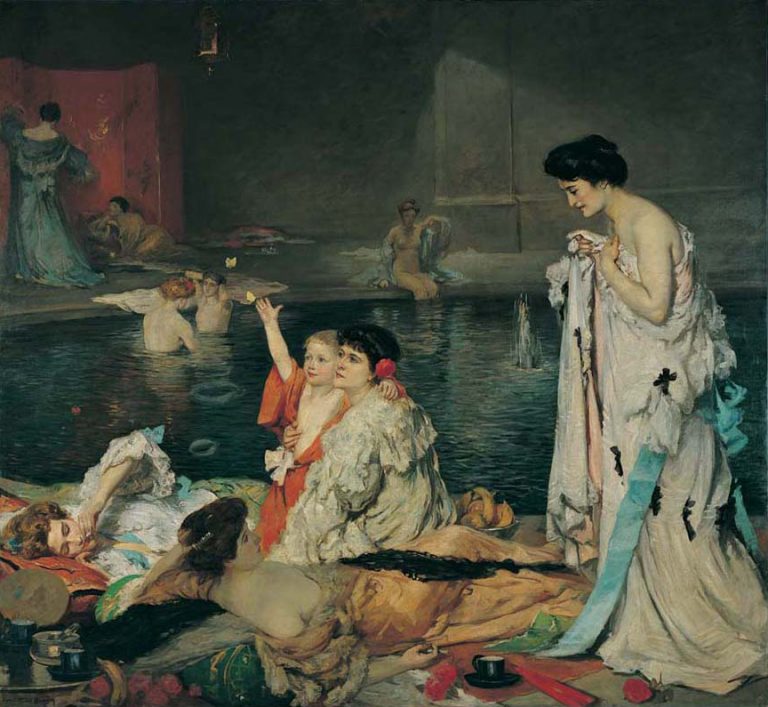We acknowledge the Traditional Owners of the land on which the Queensland Art Gallery | Gallery of Modern Art stands and recognise the creative contribution First Australians make to the art and culture of this country.

Rupert Bunny / Australia/France 1864–1947 / Bathers 1906 / Oil on canvas / 229.2 x 250cm / Purchased 1988 / Collection: Queensland Art Gallery | Gallery of Modern Art
Rupert BunnyBathers 1906
On Display: QAG, Gallery 11
One of a series of works by Rupert Bunny featuring women at leisure, Bathers 1906 was exhibited at the Paris Salon in 1906, the year it was painted. With a scale and opulence typical of salon paintings, Bathers celebrates and exaggerates the luxuries of Edwardian life.
Bunny combines exotic Japanese kimonos and elaborate contemporary fashions in a bathhouse setting. While some of the ladies lounge in a state of undress, blowing smoke rings, the central figures recall traditional representations of the Madonna and Child.
The fallen roses symbolise the human weakness of the surrounding figures, while the rose in the hair of the mother signifies her purity. Bunny’s wife, Jeanne Morel, modelled for this figure.
Rupert Bunny was the first Australian-born artist to gain a significant reputation both in Australia and overseas. He studied in the 1880s with Arthur Streeton and Frederick McCubbin at the National Gallery of Victoria Art School in Melbourne, but most of his working life — from 1886 to 1932 — was spent in France. There, he painted and drew from life, and absorbed the traditions of sound craftsmanship and the professional approach that French painting offered.
As early as 1890, Bunny had successfully exhibited at the Paris Salon of which he was later to be elected an associate. He painted in the opulent style of nineteenth-century French tradition, creating figure compositions and landscapes that are serene and luxurious in colour and design.
Bunny loved France and, until the death of his wife Jeanne Morel in 1933, he lived and painted in Paris. He returned to Australia as an artist with a European reputation and, above all, dedication to his craft.
Discussion Questions
1. What kinds of people are depicted in this painting? How would they spend their time? Describe a day in the life of one of these people.
2. Only certain women in the early 1900s would have been able to afford the elaborate garments and the luxury of spending time at a bathhouse. How would you describe the demographic profile of these women? How were their lives different to the majority of women at that time?
Classroom Activities
1. In pairs, choose one person each from the painting to role play. Record or write a conversation between the two characters in that setting to share with your class.
2. Research the life of a privileged woman living in Paris in 1906. Using this information, write a diary entry from the perspective of one of the women depicted in Bathers.